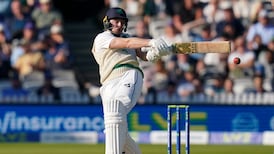Paul Howard dared me to work his new book into a column. I Read the News Today, Oh Boy has nothing whatsoever to do with athletics or sport, although it does feature racing cars and some drugs. And it takes me back to those dawn runs around Luggala Estate, often barefoot, sometimes bare-naked, off my head on nature's drunken high.
It amazes me how many people still consider running a lonely exercise. Alan Sillitoe is partly to blame, his 1959 novella The Loneliness of The Long-Distance Runner possibly the most misunderstood title in literature. His is the story not of "loneliness" but "aloneness", which Sillitoe suitably celebrates, like when first getting into the mind of his Borstal boy, Colin Smith, and why he loves to run: "Because when on a raw and frosty morning I get up at five o'clock and stand shivering my belly off on the stone floor . . . I feel like the first and last man on the world, both at once . . . It makes me feel 50 times better than when I'm cooped up in that dormitory with 300 others."
I Read the News Today, Oh Boy has nothing whatsoever to do with aloneness. It tells the story of the short and gilded life of Tara Browne, born in 1945, the youngest son of Lord Dominick Browne and Oonagh Guinness. She was a sixth-generation member of the brewing dynasty and was gifted Luggala as a wedding present.
Magical kingdom
Howard has then taken what may appear to be a minor tale of the Swinging Sixties and painted a masterpiece: after spending much of his youth within the magical kingdom of this Wicklow retreat, Browne swapped Luggala for London, became an effortlessly cool and popular player in all things cultural or psychedelic, only to be killed, instantly, when he crashed his light-blue Lotus Elan at age 21.
A month later, John Lennon was reading a newspaper report of his death, at the EMI recording studios on Abbey Road. He then touched the piano keys and came up with opening line: "I read the news today, oh boy, about a lucky man who made the grade..." That song, A Day in the Life, provided the climactic track on Sergeant Pepper's Lonely Hearts Club Band, and the rest is Beatles history.
The book opens with Browne's 21st birthday party at Luggala, in April 1966, where the guests included Mick Jagger and Brian Jones of The Rolling Stones. Jones was a close friend and arrived tripping on acid, the party later spilling out along the ancient paths of the Cloghogue Valley and the shivering dark edges of Lough Tay, where Browne now lies buried next to a small domed stone temple.
These same edges and paths traced the trail of my dawn runs during a year-long retreat to Luggala, all 6,000 acres of it, in 2013. When people ask about surviving in that stone-cut trapper’s cottage – and Luggala can by turns of the hour or light be touchingly calm or tortuously bleak – those dawn runs invariably spring to mind. No traffic, no noise, no people, nothing (and the only way of warming up until the stove began to burn).
Tripping not on acid but on my own endorphins and never once feeling isolated either, only a deeply personal transcendental meditation – there’s no better place in Ireland to experience that than Luggala at dawn.
Like when young Smith was out along the “frosty grass of an early morning when even the birds haven’t the heart to whistle”, as Sillitoe wrote, knowing “it’s a treat, being a long-distance runner, out in the world by yourself with not a soul to make you bad-tempered or tell you what to do . . . Sometimes I think that I’ve never been so free as during that couple of hours when I’m trotting up the path out of the gates.”
Still, running, for all its wondrous detachment, continues to be the world’s fastest-growing mass-participation sport. And nowhere will this be more evident than in the Dublin Marathon on Sunday week (it’s been moved from traditional Bank Holiday Monday date).
It used to be that marathon running was considered the reserve not of the lonely but the loony, only now they have to keep people away. This year’s Dublin Marathon had a maximum entry limit of 19,500 and that was reached long before the closing date. It’s now the fourth largest marathon in Europe, and there’s clearly potential for further growth.
Slowly reignited
Twenty years ago, the 1996 Dublin Marathon had only 2,700 finishers: running was in danger of becoming not just a solitary pursuit but an invisible one too. But for a variety of reasons (the tripping on endorphins included), it slowly reignited. When Jim Aughney took over as race director in 1997, there were only 2,997 entries, and within three years he got it up to 7,000. That number had almost doubled again by last year, with just over 13,000 finishers.
Now, it’s close to 20,000 , and not many sporting events can boast that sort of growth – especially given so many other towns and cities stage marathon events (Cork, Belfast, Limerick, Tralee, Dingle, Waterford, Longford, Connemara). Times are also improving, 40 per cent of finishers in Dublin last year running under four hours, compared to 25 per cent in 2000.
Still, those big city marathons aren’t for everyone, and compared to those dawn runs around Luggala Estate, having 19,500 people for company to me sounds a little bit lonely.












